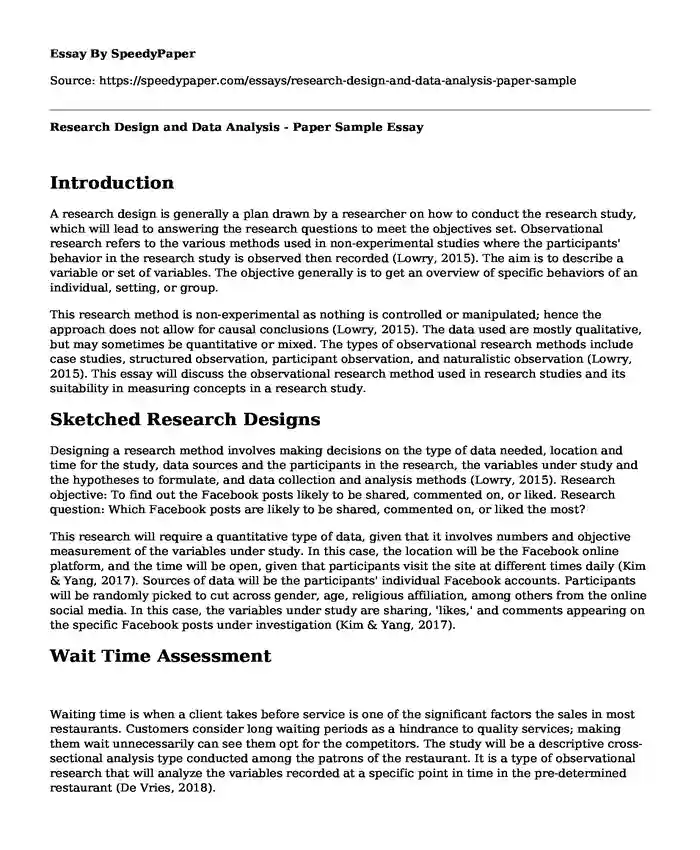
| Type of paper: | Essay |
| Categories: | Data analysis Research |
| Pages: | 3 |
| Wordcount: | 762 words |
Introduction
A research design is generally a plan drawn by a researcher on how to conduct the research study, which will lead to answering the research questions to meet the objectives set. Observational research refers to the various methods used in non-experimental studies where the participants' behavior in the research study is observed then recorded (Lowry, 2015). The aim is to describe a variable or set of variables. The objective generally is to get an overview of specific behaviors of an individual, setting, or group.
This research method is non-experimental as nothing is controlled or manipulated; hence the approach does not allow for causal conclusions (Lowry, 2015). The data used are mostly qualitative, but may sometimes be quantitative or mixed. The types of observational research methods include case studies, structured observation, participant observation, and naturalistic observation (Lowry, 2015). This essay will discuss the observational research method used in research studies and its suitability in measuring concepts in a research study.
Sketched Research Designs
Designing a research method involves making decisions on the type of data needed, location and time for the study, data sources and the participants in the research, the variables under study and the hypotheses to formulate, and data collection and analysis methods (Lowry, 2015). Research objective: To find out the Facebook posts likely to be shared, commented on, or liked. Research question: Which Facebook posts are likely to be shared, commented on, or liked the most?
This research will require a quantitative type of data, given that it involves numbers and objective measurement of the variables under study. In this case, the location will be the Facebook online platform, and the time will be open, given that participants visit the site at different times daily (Kim & Yang, 2017). Sources of data will be the participants' individual Facebook accounts. Participants will be randomly picked to cut across gender, age, religious affiliation, among others from the online social media. In this case, the variables under study are sharing, 'likes,' and comments appearing on the specific Facebook posts under investigation (Kim & Yang, 2017).
Wait Time Assessment
Waiting time is when a client takes before service is one of the significant factors the sales in most restaurants. Customers consider long waiting periods as a hindrance to quality services; making them wait unnecessarily can see them opt for the competitors. The study will be a descriptive cross-sectional analysis type conducted among the patrons of the restaurant. It is a type of observational research that will analyze the variables recorded at a specific point in time in the pre-determined restaurant (De Vries, 2018).
Wait time assessment cards and structured questionnaire will be employed to gather information on the clients' socio-demographic features, time taken before an order is taken, time spent on the queue, and time with the waiter. The research will require quantitative data, given that it involves numbers and objective measurement of the variables. The variable under study in this case is the clients' wait time. The hypothesis will be:
Walk-in clients tend to experience a longer waiting time than drive-through in major fast-food restaurants. Data collection will be through filling in assessment cards and a structured questionnaire. The analysis will be quantitative data by quintile and mean tables, dispersion measures like standard deviation or variance, median, cross-tabulations, and mode (De Vries, 2018).
Conclusion
The observational research method is useful when examining several variables simultaneously. It is also suitable for the evaluation of data collected through randomized tests. The method can effectively provide vital evidence in research where tests have not or cannot be done, and the qualitative approach is, therefore, the solution. The method is also relevant where participants' population in a research stud is large (Lowry, 2015).
References
De Vries, J., Roy, D., & De Koster, R. (2018). Worth the wait? How restaurant waiting time influences customer behavior and revenue. Journal of operations Management, 63, 59-78.
Hargittai, E., & Dobransky, K. (2017). Old dogs, new clicks: Digital inequality in skills and uses among older adults. Canadian Journal of Communication, 42(2).
Kim, C., & Yang, S. U. (2017). Like, comment, and share on Facebook: How each behavior differs from the other. Public Relations Review, 43(2), 441-449.
Liu, V., Musen, M. A., & Chou, T. (2015). Data breaches of protected health information in the United States. Jama, 313(14), 1471-1473.
Lowry, L. D. (2015). Bridging the business data divide: insights into primary and secondary data use by business researchers.
Smith, M. (2015). Where has she been and where is she going: The evolutionary portrayal of Black women in print advertising from the 1960s to 2000s.
Cite this page
Research Design and Data Analysis - Paper Sample. (2023, Dec 25). Retrieved from https://speedypaper.net/essays/research-design-and-data-analysis-paper-sample
Request Removal
If you are the original author of this essay and no longer wish to have it published on the SpeedyPaper website, please click below to request its removal:
- Royal Bank of Canada Essay Example
- Free Essay on Making Political Campaigns and Elections Better
- Free Essay Example - Presidential Discussion
- Free Essay Example on Uses of Charcoal
- Essay Example - Population Genetics and Genetic Advancements Use In Forensic Analysis
- Advantage and Disadvantages of Census - Paper Sample
- Political Ideologies after WW1 and Great Depression - Essay Sample
Popular categories




